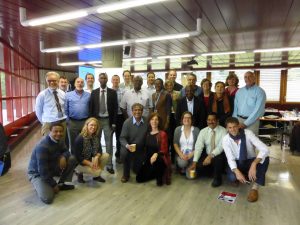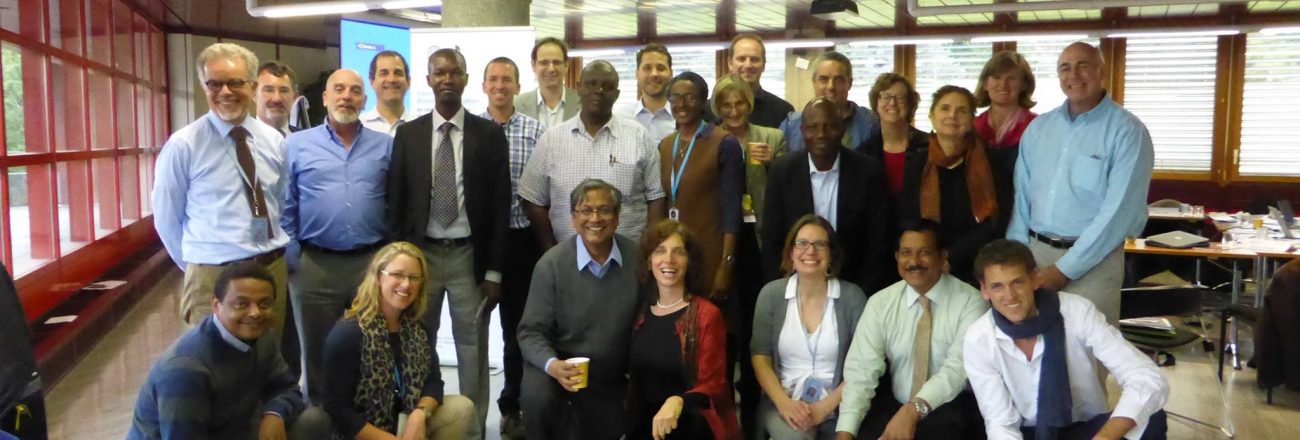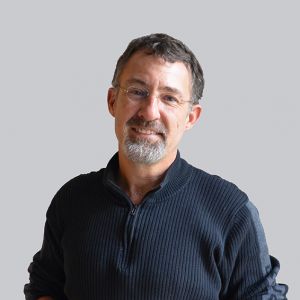
The World Health Organization’s group of “experts” convened to address energy access in healthcare.
When I wrote the first drafts of a book for the World Health Organization (WHO), Health in the Green Economy (anticipated publication date this fall), we attempted to create a crude approximation of greenhouse gas emissions for the Global Health Sector. Data was scant – we had to use various reports we had from different countries on size of health sector, emissions from parts of the sector, etc, but it was a fascinating exercise. One thing we realized was that much of the world contains health facilities that have NO access to energy, or maybe more frequently, poor access to energy. This raised all kinds of issues.
The Need for Low-Emission Solutions
First, it seemed like people were not getting healthcare because there was no energy. In reality, it was quite impossible to estimate the degree to which this was true, as there are so many reasons things were not happening; laying total causality at the foot of lack of energy was over-emphasizing the importance of energy. Second, it seemed that if these facilities were given the generally available energy sources (diesel generators), they would add to the burden of rising CO2 levels that are so imminently problematic. This led to the obvious conclusion that we needed to develop low-emission solutions for these situations, but much of the world is littered with such systems that are broken or never worked in the first place. (This, by they way, was one reason for creating the Sextant Foundation, to start tackling this problem.)
Over time, I have come across many others who are waking to the same issue. And last week, I was honored to be part of a “convening of experts” to explore this issue with the WHO. The WHO is focused on identifying high impact opportunities for increasing the health of the world’s people, and they see this as one potential lever.
Facing a Complicated Problem
But, the problem is not as easy as it might first appear. Issues of access to energy include: availability (there were stories of countries where a high-voltage line passed over a village, and it was counted as having electricity available in official statistics); hours of operation (utilities in many countries operate intermittently at best); quantity; cost (in some places a birthing mom must bring with her an unaffordable amount of money for the generator if she wants lights on while being treated); quality (power quality in many places is so poor that it damages equipment – if it were working in the first place); and maintainability (donors install solar systems, but fail to provide ongoing maintenance, so the systems often fail only to become another broken piece of equipment in a place full of need).
At the end of the day, the issue is money – the need to pay for systems that will provide the energy needed to provide health services at all.
Nine Conclusions From WHO
We reached a number of important conclusions at the meeting, I think:
- Lots of small entrepreneurial efforts are underway to help address this issue (Sextant is one of them).
- There is a serious need to document the extent of the problem but little agreement (not to mention, resources) for how to do it. We had a working group spend a day wrestling with this problem, and we made headway that I hope will help the WHO.
- There is a serious need to document the degree to which energy poverty is a cause (not a correlation) for lack of services. This was of particular interest to me. The “developed country mindset” is to think in terms of outcomes. e.g. If we install this special ventilation system, how will it impact the transmission of airborne infectious agents? How will that translate into outcomes and reimbursement for the facility? For the majority of the world’s people, though, the issue is not one of effectiveness of service; the question is, can we have the service AT ALL? My friends at WHO said there is no existing published peer-reviewed literature on this topic. Because of this, we will be developing white papers to illustrate the impact or our Philippines clinics. (At a recent ribbon cutting, mayor after mayor, public health person after public health person, doctor after doctor, thanked us for the solar electricity and clean water we were providing – great, but we must document it.)
- Infrastructure of all kinds is somewhat implied but often ignored, in the development and operation of most health facilities.(e.g. Means for basic cleaning are extremely important and depend upon light or heat for sterilization.) Health professionals get accustomed to their current condition, figure out “work-arounds” or even choose to practice somewhere else where they can have access to energy supply, but also, critically, clean water.
- There are many wonderful people trying to make a difference on the issue. Indeed, I was somewhat overwhelmed by the passion of so many people, all trying to talk about what they were doing to address/resolve the problem. I think there is need, maybe, to coordinate these efforts. Nobody has a monopoly on good ideas. Nobody has enough resources to make even the tiniest of dints. I am hopeful that the community that came together last week in Geneva, continues its work together. I would like to see an international guideline for health system operations that would drive a set of simple standards for health facilities that could be easily replicable. I think this can be done partially through the private sector, not funded with capital dollars but with some kind of operating lease. (Sextant and others are already doing this with energy systems.) One participant described going into a hospital in Africa and seeing five different solar systems installed by previous NGOs. All of them had been well intentioned. All of them had done good work. All of them were different. None of them worked. None of them had on-site documentation so that the next well-meaning NGO could figure them out. None of them were designed to be expanded upon by the next NGO; they were all self-contained and proprietary. We need to develop systems that are more standardized and easier to hand off to the next party.
- There is urgent need for development and mass deployment of low-energy medical equipment. I am happy to say, this was an issue I raised many years ago when we started our HGE book, and others (See Reverse Innovation by Govindarajan) were also discovering it in other ways. And, progress is being made, but much more is needed. In part, this is a need for health system planning.
- Coordinated health system planning is possibly the biggest need. It was interesting, while I was working with FGI to help craft a vision of the future of healthcare to help outline the next version of the Guidelines, a future job category our experts predicted was “health system engineer.” By this, they did not mean the kind of engineer I am and I employ today (the kind who design mechanical or electrical systems for healthcare facilities); they meant people who could design health delivery systems, including the logistics (and low-energy medical devices) that would serve the needs as they evolved, and in a coordinated way that capitalizes on new, low-energy devices. And the systems would be modular so that the next NGO could build upon, not replace, what the last one did.
- On the other hand, I am cautious about too much centralization. I have seen enough big organizations to know the inevitable bureaucracy and mental prisons they can inevitably become. There is genius to a system of lots of restlessly striving small entrepreneurs exercising their creativity to develop the next great idea. I think the right idea is to harness and manage this diversity, not to replace it with a large centralized scheme
- I was struck again by the disparity between the way most of the world thinks and the way we think about things in the US. I was spending my days in Geneva working on the issues of having no access to energy. Then, with the time change, I would spend evenings on the phone or on email – a second day’s worth of work. One night, I was talking to one of my US Colleagues. He was frustrated that the plan checker for a state, in which we work, was requiring a “ridiculous” amount of additional documentation for simple changes. I was so struck by the ways we spend our resources here, because, I guess, we have so much. The contrast with talking about the rest of the world who has nothing was stark.
Anyway, it was such an honor to be part of that group. It inspired me to keep working with my partners towards building better buildings wherever we practice, even as we re-invent our own organization to try to respond to the evolving market. It inspired me to keep thinking about new ways to organize healthcare and health infrastructure. And it inspired me to continue the work of our little employee-owned B-corporation to develop these systems where we can and serve that little bit of need that’s accessible to us.
Walt
Interested in what you see? Subscribe to receive monthly news and information
more tailored to what you need.

